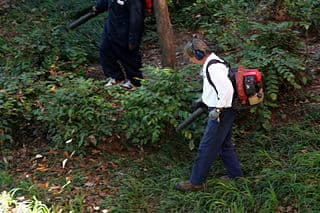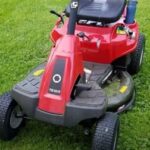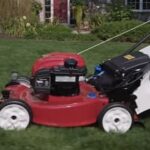As an Amazon Associate, this site earns commissions from qualifying purchases. For more information click here.
The ignition coil generates the spark required for fuel to work. If this part does not work, your gas leaf blower will not function. So it is a good idea to test the leaf blower ignition coil regularly. By following these steps you will learn how to do it properly. All it takes is a bit of patience.
Remove the screws on the motor outer casing and disconnect the wire that goes into the spark plug. Next, unfasten the bolts that secure the ignition coil. Once the ignition coil is free, use a multimeter or ohm meter to check if it is working properly.
How to Test Leaf Blower Ignition Coil Step by Step
There are many ways to test ignition coils, but using a multimeter or ohm meter is the most effective. Whichever testing device you use the process is basically the same: disconnect the ignition coil and use a multimeter to verity it works.
A traditional way of testing an ignition coil goes like this. Crack the engine, unplug the spark plug wire and press onto the metal chassis. If it sparks, the ignition coil is fine. If it does not, there is a problem.
While this method is accurate, it is hazardous. You are vulnerable to an electric shock and there is the threat of fire. Using an ohm meter, voltmeter or multimeter is safer and easier.
There are two reasons why this method is popular. First, it is safe. You do not have to make contact with the cables, which can be risky as the engine is on. Second, it works with any type of ignition coil whether it is on a leaf blower, lawn mower or other machines.
You will need:
- Screwdrivers and wrenches to remove screws and bolts
- Pliers
- Multimeter (the AstroAI is ideal for this)
Before You Begin. There are two things you need to do. First, consult your owner’s manual to find out the correct resistance reading. This will vary depending on the make and model. Go to the manufacturer website if you no longer have the manual.
This video shows how a typical ignition coil test is done. If you would like to read the instructions, follow the steps given here.
While you are at it, take note of the specifications and features of your leaf blower, as this will vary from others. This information might come in handy in case your leaf blower starts smoking.
The second thing is learn how to use your multimeter. There are many types available, each with their own unique features. Make sure you know how your device works so you can interpret the results accurately.
Step 1. Use a screwdriver to remove the screws on the motor casing. Set the screws aside and lift the cover.
The ignition coil should be visible now. Some leaf blowers have an additional cover so you may have to remove that too. Eventually you will come across the ignition coil close to the flywheel. You will also see a wire linking the coil to the spark plug.
Step 2. Remove the wire that is going through the spark plug. Hold your pliers and carefully remove the bolts that secure the ignition coil.
Once you have removed the screws, the coil will hang loosely. Make sure you keep all those screws and bolts you removed nearby. You have to put them back later.
Step 3. Pull the ignition coil from its mount. If there is a cable connected to it, loosen it at the section where it is fastened to the chassis.
Step 4. Now it is time to test it with your multimeter. Be mindful of the motor resistance level before proceeding. If you have not done so yet, set the device to ohms. You can also use an ohm meter instead.
Plug the black probe of the multimeter onto the ignition coil. Plug the red probe onto the spark plug. Ensure the connectors are firm and secure.
Set the ignition coil on a table or any even surface. Set the multimeter to 20ohms or whatever is suitable for your leaf blower.
Connect the + end of the multimeter onto the spark plug metal loop. For the – end of the multimeter, connect it to the coil metal armature. Scratch the leads a bit to secure it.
If you have a digital multimeter like the Klein Tools MM600 , there will be a screen for displaying numeric figures. If you have an analog voltmeter or ohm meter, watch out for the pointer movements.
Step 5. If you used the multimeter properly a reading will register. If the reading states ‘1’, resistance is 100%. It also means no connection was established. If you are certain the connection is secure, then the ignition coil is not functioning properly.
The reading should be at least 0.4 ohms. The specific reading will depend on what type of motor your leaf blower has.
Step 6. What you do next depends on the results of the reading. If the ignition coil is fine, go to step 7 and put everything back together again.
Step 8. If the ignition coil does not work, you have to replace it. Take note of its specs and go to the manufacturer website. Find the exact copy and place an order.
Or you can take the damaged ignition coil to a hardware / outdoor equipment store. Show them the ignition coil and you should be able to buy an exact replacement.
When you have the new ignition coil, proceed to step 9.
Step 9. Install the new ignition coil. Take note of the steps earlier on how remove the coil and do it in reverse.
If your leaf blower comes with a ground wire, connect it to the chassis. Next, connect the armature metal, being mindful of the space between it and the flywheel. Put back all the screws you removed earlier.
Step 10. The last step is to hook up the spark plug and the plug wire. Turn the leaf blower on and it should run fine.
How Leaf Blower Ignition Coil Testing Works
Learning how to read the results of your ignition coil test is one thing. Knowing what to do about it is another. Here it helps to understand how leaf blower ignition coils work so if there is a problem you will know what to look for.
The ignition coil links the flywheel and the spark plug and is a vital engine component. The ignition coil, flywheel and spark plug come to life when you pull the starter cord on a gas powered leaf blower. On electric leaf blowers, the cord has been replaced by a start button.

Ignition coils have the same function, whether it is in a leaf blower or another power tool. It supplies the electric sparks required for fuel ignition.
Usually the ignition coil is in the motor section of your leaf blower. In most cases it is hidden behind a cover. That is why you have to remove this before you can do any testing.
An insulated wire links the coil to the metal armature off the tip of the spark plug. The armature is set onto the engine frame. These components along with the flywheel are interconnected. When you pull the starter cord on a gas leaf blower or turn the switch on an electric model, the ignition cord generates the spark that brings the motor to life.
How Spark Plug Problems Affect Ignition Coils
Now you know how to test the ignition coil to check if it is working. But what if you replaced the coil and the leaf blower still will not run?
The most likely reason is a problem with the spark plug. As explained earlier, the ignition coil and spark plug function together to run the motor.
Here are the most common reasons why a spark plug can fail.
Carbon deposits. The ends of the spark plug metal tip have to be free of carbon deposits. The tip links to the motor and enables sparks to appear, making combustion possible.
If the tip is covered in carbon deposits or worn out, the fuel will not light. The solution for these carbon deposits is clean the spark plug or replace it. Replacement is the only option for a worn out spark plug.
Stop switch. There could also be a problem with the stop switch. This applies only to electric leaf blowers and will affect the on/off switch. The switch has to be replaced otherwise there will be problems with idling.
Faulty wiring. There is a wire that sends the current from the ignition coil to the spark plug. If the wire is rusty, corroded or comes loose, replace it right away. If you do not, the leaf blower will not run.
In general it is better to replace a problematic sparkplug. cleaning only provides a temporary solution. By getting a new one you can expect it to function well for a long time.

I love the outdoors and all the tools for maintaining gardens, yards and lawns. The only thing I am more passionate about is sharing what I know about garden and outdoor equipment.


